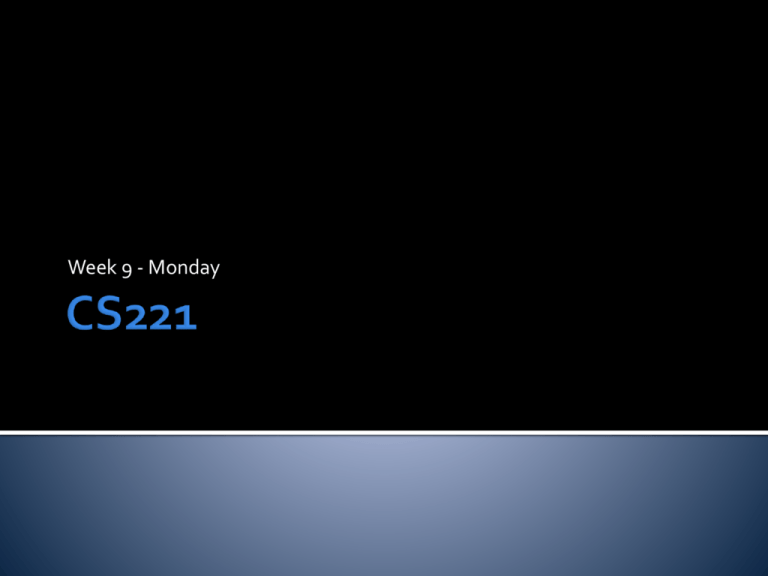Slides
advertisement

Week 9 - Monday What did we talk about last time? Practiced with red-black trees AVL trees Balanced add Takes a potentially unbalanced tree and turns it into a balanced tree Step 1 Turn the tree into a degenerate tree (backbone or vine) by right rotating any nodes with left children Step 2 Turn the degenerate tree into a balanced tree by doing sequences of left rotations starting at the root The analysis is not obvious, but it takes O(n) total rotations How much time does it take to insert n items with: Red-black or AVL tree Balanced insertion method Unbalanced insertion + DSW rebalance How much space does it take to insert n items with: Red-black or AVL tree Balanced insertion method Unbalanced insertion + DSW rebalance Balanced binary trees ensure that accessing any element takes O(log n) time But, maybe only a few elements are accessed repeatedly In this case, it may make more sense to restructure the tree so that these elements are closer to the root 1. Single rotation Rotate a child about its parent if an element in a child is accessed, unless it's the root 2. Moving to the root Repeat the child-parent rotation until the element being accessed is the root A concept called splaying takes the rotate to the root idea further, doing special rotations depending on the relationship of the child R with its parent Q and grandparent P Cases: 1. Node R's parent is the root Do a single rotation to make R the root 2. Node R is the left child of Q and Q is the left child of P (respectively right and right) Rotate Q around P Rotate R around Q 3. Node R is the left child of Q and Q is the right child of P (respectively right and left) Rotate R around Q Rotate R around P We are not going deeply into self-organizing trees It's an interesting concept, and rigorous mathematical analysis shows that splay trees should perform well, in terms of Big O bounds In practice, however, they usually do not An AVL tree or a red-black tree is generally the better choice If you come upon some special problem where you repeatedly access a particular element most of the time, only then should you consider splay trees Student Lecture We can define a symbol table ADT with a few essential operations: put(Key key, Value value) ▪ Put the key-value pair into the table get(Key key): ▪ Retrieve the value associated with key delete(Key key) ▪ Remove the value associated with key contains(Key key) ▪ See if the table contains a key isEmpty() size() It's also useful to be able to iterate over all keys We have been talking a lot about trees and other ways to keep ordered symbol tables Ordered symbol tables are great, but we may not always need that ordering Keeping an unordered symbol table might allow us to improve our running time Balanced binary search trees give us: O(log n) time to find a key O(log n) time to do insertions and deletions Can we do better? What about: O(1) time to find a key O(1) to do an insertion or a deletion We make a huge array, so big that we’ll have more spaces in the array than we expect data values We use a hashing function that maps keys to indexes in the array Using the hashing function, we know where to put each key but also where to look for a particular key Let’s make a hash table to store integer keys Our hash table will be 13 elements long Our hashing function will be simply modding each value by 13 Insert these keys: 3, 19, 7, 104, 89 0 1 2 4 5 3 104 0 3 1 2 3 4 5 6 7 19 7 6 7 8 9 10 11 12 89 8 9 10 11 12 Find these keys: 3 104 0 1 19 YES! 88 NO! 16 NO! 2 3 4 5 19 7 6 7 89 8 9 10 11 12 We are using a hash table for a space/time tradeoff Lots of space means we can get down to O(1) How much space do we need? How do we pick a good hashing function? What happens if two values collide (map to the same location) We want a function that will map data to buckets in our hash table Important characteristics: Efficient: It must be quick to execute Deterministic: The same data must always map to the same bucket Uniform: Data should be mapped evenly across all buckets We want a function h(k) that computes a hash for every key k The simplest way of guaranteeing that we hash only into legal locations is by setting h(k) to be: h(k) = k mod N where N is the size of the hash table To avoid crowding the low indexes, N should be prime If it is not feasible for N to be prime, we can add another step using a prime p > N: h(k) = (k mod p) mod N Pros Simple Fast Easy to do Good if you know nothing about the data Cons Prime numbers are involved (What’s the nearest prime to the size you want?) Uses no information about the data If the data is strangely structured (multiples of p, for example) it could all hash to the same location Break the key into parts and combine those parts Shift folding puts the parts together without transformations SSN: 123-45-6789 is broken up and summed 123 + 456 + 789 = 1,368, then modded by N, probably Boundary folding puts the parts together reversing every other part of the key SSN: 123-45-6789 is broken up and summed 123 + 654 + 789 = 1,566, then modded by N, probably Pros Relatively Simple and Fast Mixes up the data more than division Points out a way to turn strings or other non- integer data into an integer that can be hashed Transforms the numbers so that patterns in the data are likely to be removed Cons Primes are still involved Uses no special information about the data Square the key, then take the “middle” numbers out of the result Example: key = 3,121 then 3,1212 = 9,740,641 and the hash value is 406 One nice thing about this method is that we can make the table size be a power of 2 Then, we can take the log2 N middle bits out of the squared value using bitwise shifts and masking Pros Randomizes the data a lot Fast when implemented correctly Primes are not necessary Cons Uses no special information about the data Remove part of the key, especially if it is useless Example: Many SSN numbers for Indianapolis residents begin with 313 Removing the first 3 digits will, therefore, not reduce the randomness very much, provided that you are looking at a list of SSN’s for Indianapolis residents Pros Uses information about the key Can be efficient and easy to implement Cons Requires special knowledge Careless extraction of digits can give poor hashing performance Change the number to a different base Then, treat the base as if it were still base 10 and use the division method Example: 345 is 423 in base 9 If N = 100, we could take the mod and put 345 in location 23 Pros If many numbers have similar final digits or values mod N (or p), they can be randomized by this method Cons Choice of base can be difficult Effects are unpredictable Not as quick as many of the other methods Values that didn’t collide before might now collide Determine if a string has any duplicate characters Weak! Okay, but do it in O(m) time where m is the length of the string Collisions Chaining implementation of hash tables Keep working on Project 3!








